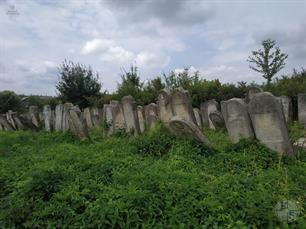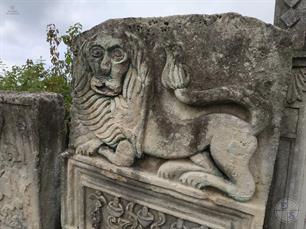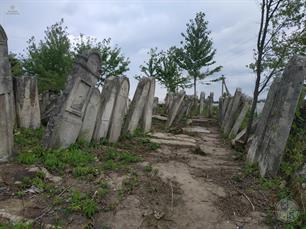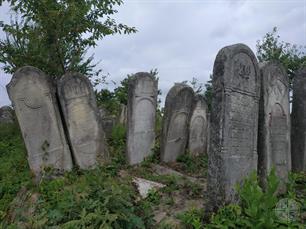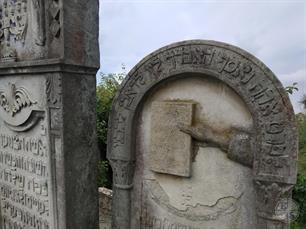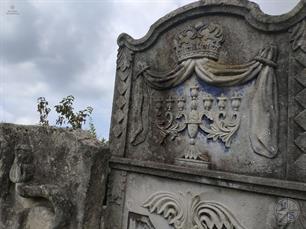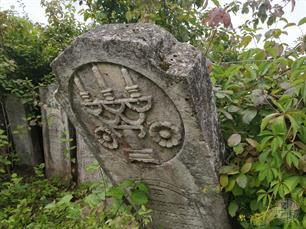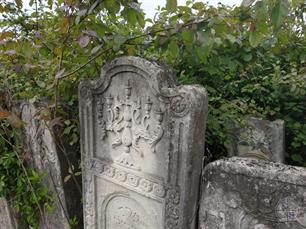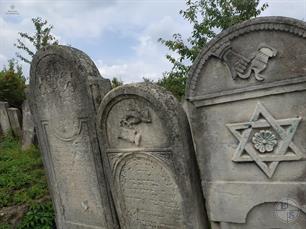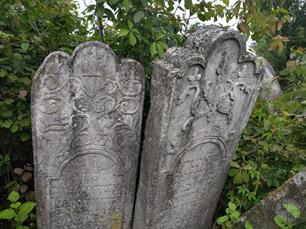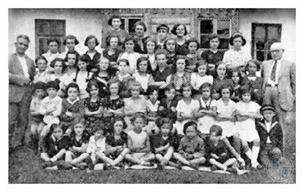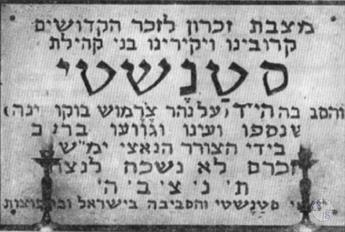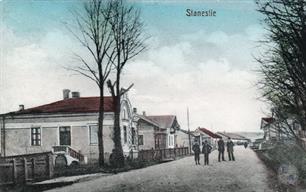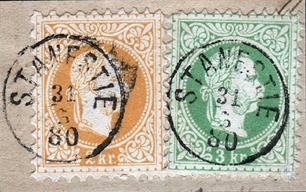Nyzhni Stanivtsi
Sources:
- Josef Schapira. Unter Stanestie / Geschichte der Juden in der Bukowina (History of the Jews in the Bukowina), vol. II. Edited by Hugo Gold. Tel Aviv: Olamenu, 1962. Translated from German by Jerome Silverbush z”l, JewishGen, Inc
- Russian Jewish encyclopedia
- Irv Osterer. Nizhniye Stanovtsy
Photo:
- European Jewish Cemeteries Initiative. Nyzhni Stanivtsi Jewish Cemetery
- Center for Jewish Art. Jewish cemetery in Nyzhni Stanivtsi
- Postcard collection of Peter Elbau
- Josef Schapira. Unter Stanestie / Geschichte der Juden in der Bukowina (History of the Jews in the Bukowina), vol. II. Edited by Hugo Gold. Tel Aviv: Olamenu, 1962. Translated from German by Jerome Silverbush z”l, JewishGen, Inc
- Russian Jewish encyclopedia
- Irv Osterer. Nizhniye Stanovtsy
Photo:
- European Jewish Cemeteries Initiative. Nyzhni Stanivtsi Jewish Cemetery
- Center for Jewish Art. Jewish cemetery in Nyzhni Stanivtsi
- Postcard collection of Peter Elbau
Nyzhni Stanivtsi (Lower Stanesti, Stanestie de Jos, Unter-Stanestie; ukr. Нижні Станівці) known from 1596. In the 19th-early 20th centuries-the village of Unter-Estestra of the Kotzmansky elder of the province of Bukovin as part of Austria-Hungary. In 1918–40 - as part of Romania, in 1940–91 - as part of the Ukrainian SSR.
The first settlers were teamsters who carried logs and lumber to the border cities of Galicia. They were soon joined by other Jews who ran small retail businesses and who lived under the most difficult conditions. We also know the names of craftsmen and founders of small industrial firms around 1850. David Melzer was a soap and candle manufacxturer. There was a soda water factory that was run by Meschulen Bleiweiss and his sons and later an oil press owned by Leiser Hubner. David Suessmann produced beams in a primitive way with hand saws.
Also a doctor by the name of Dr. Peller and a military barber, Jerichim Plutzer whose wife Seide was a midwife lived in the town. The majority of the population couldn't make a living and this caused a large number to emigrate to America. Many found prosperity in the strange land. Later under the liberal Austrian regime, the middle class grew. The alcohol distillery and two mills were in Jewish hands. Mechel Leb Osterer and Binem Schapira leased the mills.
The trade with agricultural products blossomed, the more so as the lessees of the estates were without exception Jewish. We know the names of the Jewish lessee Hersch Luttinger, Tennen, Moses Lilienfeld (who also had a rabbi's diploma) and M. Weissglas.
Almost every Jewish inhabitant had their own house with a fruit and vegetable garden which the family worked and also one or two head of cattle. A Kultusgemeinde 1 was started to which the Jews of the neighboring villages of Woloka, Berbeatie, Kalinestie, Costesti, Kabesti, Ober-Stanestie, Hlinitgza, Draczinetz and Selenau belonged.
The first president of the community was Mosiu Hager, a relative of the Wiznitz grand rabbi. After his death the honor of rabbi passed to his son Isak Meier Hager. The secretary and religion teacher was at this time, Sindel Suesmann.
The first settlers were teamsters who carried logs and lumber to the border cities of Galicia. They were soon joined by other Jews who ran small retail businesses and who lived under the most difficult conditions. We also know the names of craftsmen and founders of small industrial firms around 1850. David Melzer was a soap and candle manufacxturer. There was a soda water factory that was run by Meschulen Bleiweiss and his sons and later an oil press owned by Leiser Hubner. David Suessmann produced beams in a primitive way with hand saws.
Also a doctor by the name of Dr. Peller and a military barber, Jerichim Plutzer whose wife Seide was a midwife lived in the town. The majority of the population couldn't make a living and this caused a large number to emigrate to America. Many found prosperity in the strange land. Later under the liberal Austrian regime, the middle class grew. The alcohol distillery and two mills were in Jewish hands. Mechel Leb Osterer and Binem Schapira leased the mills.
The trade with agricultural products blossomed, the more so as the lessees of the estates were without exception Jewish. We know the names of the Jewish lessee Hersch Luttinger, Tennen, Moses Lilienfeld (who also had a rabbi's diploma) and M. Weissglas.
Almost every Jewish inhabitant had their own house with a fruit and vegetable garden which the family worked and also one or two head of cattle. A Kultusgemeinde 1 was started to which the Jews of the neighboring villages of Woloka, Berbeatie, Kalinestie, Costesti, Kabesti, Ober-Stanestie, Hlinitgza, Draczinetz and Selenau belonged.
The first president of the community was Mosiu Hager, a relative of the Wiznitz grand rabbi. After his death the honor of rabbi passed to his son Isak Meier Hager. The secretary and religion teacher was at this time, Sindel Suesmann.
Vyzhnytsya district, Chernivtsi region
After Germany's declaration of war on Russia (June 22, 1941) the disaster ran its course. Already on June 27, the armed Ukrainian population gathered in the church to discuss the annihilation of the Jewish population of the town. On this day, almost all the Jewish men and those women who didn't want to be separated from their husbands and sons were locked in the courthouse. At the same time, the murders held a “trial” in the community building in which the Jews were condemned to death.
On July 28 65 Jews were divided into groups and murdered. A group was taken to the hill overlooking the Fischer estate and a second group was taken to the saw mill on the Vivos and there were murdered in a bestial way with axes and other household tools. The first victim was Wagner and among the others were Rabbi Friedlaender and his two sons. It was like a miracle that Abraham Suessmann could rescue himself by running bound and half naked ran into a nearby forest. He lives today in America. The killing went on for three days.
At the same time the surviving old people, widows and orphans were rounded up by the Romanian police and taken to Waschkoutz and from there taken on August 1 to Jedinetz (Bessarabien). The majority of the unfortunates died from stress and starvation. Those who didn't come along were shot and many were buried alive. The survivors went by foot to Berschad, Moghilew, Murafa, Vapniarka, Tulczin and other towns of Transnistrien. Many of these people were taken over the Bug to German slave labor camps from which no one returned alive. In three years, 172 residents of the town of Stanestie died in Transnistrien.
In 1944 the last survivors prepared to go home, but had to wait in Chernivtsi because in the forests around Stanestie, the Banderowzies (named after the Ukrainian Stefan Bandera) were murdering any returnees who fell into their hands. In 1945, the Russians allowed many Jews from Chernivtsi to be repatriated to Romania. Most of the Stanestie refugees made use of this permission and went to Romania. Many of them were able to go to Israel.
On July 28 65 Jews were divided into groups and murdered. A group was taken to the hill overlooking the Fischer estate and a second group was taken to the saw mill on the Vivos and there were murdered in a bestial way with axes and other household tools. The first victim was Wagner and among the others were Rabbi Friedlaender and his two sons. It was like a miracle that Abraham Suessmann could rescue himself by running bound and half naked ran into a nearby forest. He lives today in America. The killing went on for three days.
At the same time the surviving old people, widows and orphans were rounded up by the Romanian police and taken to Waschkoutz and from there taken on August 1 to Jedinetz (Bessarabien). The majority of the unfortunates died from stress and starvation. Those who didn't come along were shot and many were buried alive. The survivors went by foot to Berschad, Moghilew, Murafa, Vapniarka, Tulczin and other towns of Transnistrien. Many of these people were taken over the Bug to German slave labor camps from which no one returned alive. In three years, 172 residents of the town of Stanestie died in Transnistrien.
In 1944 the last survivors prepared to go home, but had to wait in Chernivtsi because in the forests around Stanestie, the Banderowzies (named after the Ukrainian Stefan Bandera) were murdering any returnees who fell into their hands. In 1945, the Russians allowed many Jews from Chernivtsi to be repatriated to Romania. Most of the Stanestie refugees made use of this permission and went to Romania. Many of them were able to go to Israel.
During the war 1914/1918 the Jewish inhabitants of the town suffered under the changing conditions the most. The entry of the Russian army units and their retreat caused the Jews to pay a heavy toll in their fortunes and their lives. Many families fled and left all their possessions behind.
After the war, the survivors returned to try and take up their existence again. Many fell in the fighting and many ended as prisoners of war. (Ensign Moses Stern who was captured by the Russians was said to have later led the Russian operation in Finland as a general. The Stanestie residents dreamt after the fall of the monarchy of the creation of a Ukrainian state and tried to enlist the Jews in their movement.
Things turned out differently, however. The Romanian government caused the same suffering for the Jews of Stanestie as it did for the Jews in the other towns of Bukovina. At first, progress was made on the reconstruction. David Kaczer, a native of Stanestie, came from America and founded a Joint 2 bank and made large sums of money available.
The newly installed community was led by estate owner Abraham Osterer, then Jidl Ruebner and later by Dr. Jakob Herer. Rabbi Friedlaender was chosen as rabbi.
The Zionist movement made great steps forward and the Zionist fund received considerable contributions in Stanestie. In the interest of nationalist youth education, a Hebrew school (Safa Iwria) was opened.
On June 29, 1940 the Red Army occupied Stanestie. This resulted in the deportation and annihilation of many Jewish families. Many Jews had to give up their previous occupation and were forced to take a job working for the government, which however, after the withdrawal of the Russians led to their doom since the Ukrainians of the town used this circumstance as an excuse to denounce the Jews as notorious Communists and to be able to rob and murder them unpunished.
After the war, the survivors returned to try and take up their existence again. Many fell in the fighting and many ended as prisoners of war. (Ensign Moses Stern who was captured by the Russians was said to have later led the Russian operation in Finland as a general. The Stanestie residents dreamt after the fall of the monarchy of the creation of a Ukrainian state and tried to enlist the Jews in their movement.
Things turned out differently, however. The Romanian government caused the same suffering for the Jews of Stanestie as it did for the Jews in the other towns of Bukovina. At first, progress was made on the reconstruction. David Kaczer, a native of Stanestie, came from America and founded a Joint 2 bank and made large sums of money available.
The newly installed community was led by estate owner Abraham Osterer, then Jidl Ruebner and later by Dr. Jakob Herer. Rabbi Friedlaender was chosen as rabbi.
The Zionist movement made great steps forward and the Zionist fund received considerable contributions in Stanestie. In the interest of nationalist youth education, a Hebrew school (Safa Iwria) was opened.
On June 29, 1940 the Red Army occupied Stanestie. This resulted in the deportation and annihilation of many Jewish families. Many Jews had to give up their previous occupation and were forced to take a job working for the government, which however, after the withdrawal of the Russians led to their doom since the Ukrainians of the town used this circumstance as an excuse to denounce the Jews as notorious Communists and to be able to rob and murder them unpunished.
The number of Jews at that time was 4000, among whom, 450 were tax payers. The community had a ritual slaughterer and erected a ritual bath. Leib Weissmann and Leiser Blum were honorary religious court judges. There was a large synagogue in the town and two small prayer houses. The exocentric Jankale Bijinauer, the “forest rabbi” should be mentioned, since he lived in the woods like a hermit. He substituted the prescribed daily bath with a dip in the Brusinita creek even in the depth of the winter. Often he had to clear away the ice before he went in the water.
Also the humorous tailor, who was once even given an audience by the Kaiser in Vienna, was much gossiped about. Among the curiosities of the community, David Engel should be mentioned. He spent the better part of his life studying the sacred writings and was especially noted because of tune he used in studying and by his interpretation of the Talmud.
Around the turn of the century (1890-1914) a modern spirit became apparent in Stanestie. Many families sent their children to higher education and the youth was ambitious and hard working. Prosperity was growing. The estate previously leased by Jews from a Polish noble family was acquired by Kalman Fischer. Abraham Osterer was also an estate owner. Smaller land owners were Schlomo Ruebner, Schulem Haber and Mathes Birnbaum.
The Jews were also craftsmen. Shoemakers, tailors, backers, watchmakers, carpenters, plumbers, barbers, locksmiths, coopers, distillers and blacksmiths were exclusively Jewish.
Even the majority of officials were Jewish. We should mention the district judge, Dr. Isidor Lutwak, and the police chief Jude Riegler, The Jewess Fuhrmann was a teacher in the public school.
Before the war, doctors, lawyers and pharmacists were, as in all other Bukovina towns, were Jewish. Two examples are the doctor, Dr. Emanuel Braun and the lawyer, Dr. Markus Sternberg.
Also the humorous tailor, who was once even given an audience by the Kaiser in Vienna, was much gossiped about. Among the curiosities of the community, David Engel should be mentioned. He spent the better part of his life studying the sacred writings and was especially noted because of tune he used in studying and by his interpretation of the Talmud.
Around the turn of the century (1890-1914) a modern spirit became apparent in Stanestie. Many families sent their children to higher education and the youth was ambitious and hard working. Prosperity was growing. The estate previously leased by Jews from a Polish noble family was acquired by Kalman Fischer. Abraham Osterer was also an estate owner. Smaller land owners were Schlomo Ruebner, Schulem Haber and Mathes Birnbaum.
The Jews were also craftsmen. Shoemakers, tailors, backers, watchmakers, carpenters, plumbers, barbers, locksmiths, coopers, distillers and blacksmiths were exclusively Jewish.
Even the majority of officials were Jewish. We should mention the district judge, Dr. Isidor Lutwak, and the police chief Jude Riegler, The Jewess Fuhrmann was a teacher in the public school.
Before the war, doctors, lawyers and pharmacists were, as in all other Bukovina towns, were Jewish. Two examples are the doctor, Dr. Emanuel Braun and the lawyer, Dr. Markus Sternberg.

- Home
- Shtetls
- Vinnytsia region
- Volyn region
- Dnipro region
- Donetsk region
- Zhytomyr region
- Zakarpattia region
- Zaporizhzhia region
- Ivano-Frankivsk region
- Kyiv region
- Kropyvnytskyi region
- Luhansk region
- Lviv region
- Mykolayiv region
- Odessa region
- Poltava region
- Rivne region
- Sumy region
- Ternopil region
- Kharkiv region
- Kherson region
- Khmelnytskyi region
- Chernihiv region
- Chernivtsi region
- Cherkasy region
- Crimea
- Synagogues
- Cemeteries
- Objects & guides
- Old photos
- History
- Contact
Jewish towns of Ukraine
My shtetl
My shtetl
Donate
Jewish towns of Ukraine
